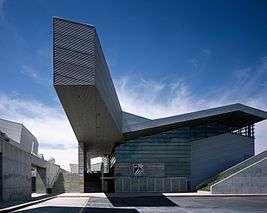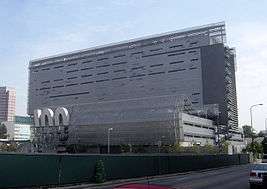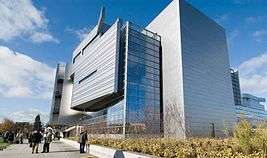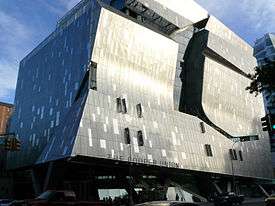Thom Mayne
| Thom Mayne | |
|---|---|
| Born |
January 19, 1944 Waterbury, Connecticut, United States |
| Nationality | American |
| Alma mater | University of Southern California, Harvard University |
| Occupation | Architect |
| Awards |
AIA Gold Medal Pritzker Prize Rome Prize |
| Website |
www |
| Practice | Morphosis |
| Buildings | Diamond Ranch High School, University of Toronto Graduate House, Caltrans District 7 Headquarters, Wayne L. Morse United States Courthouse, San Francisco Federal Building, New Academic Building at 41 Cooper Square, Perot Museum of Nature and Science, Emerson College Los Angeles |
Thom Mayne (born January 19, 1944) is an American architect. He is based in Los Angeles. Mayne helped found the Southern California Institute of Architecture (SCI-Arc) in 1972, where he is a trustee. Since then he has held teaching positions at SCI-Arc, the California State Polytechnic University, Pomona (Cal Poly Pomona)[1] and the University of California, Los Angeles (UCLA). He is principal of Morphosis, an architectural firm in Santa Monica, California. Mayne received the Pritzker Architecture Prize in March 2005.[2]
Early life and career

Mayne was born in Waterbury, Connecticut. He studied architecture at the University of Southern California (1968)[3] and also studied at the Harvard University Graduate School of Design in 1978, with a social agenda and urban planning focus, receiving his bachelor's degree, he began working as an urban planner under Korean-born architect Ki Suh Park. During that time he recalls that "policy and planning were not going to work for me" and that he "needed a more tangible resolution.”[4] Mayne found himself living on a commune with the grass-roots group Campaign for Economic Democracy, many of whom became his earliest clients.
In 1972, Mayne abruptly left Cal Poly Pomona[5] and collaborated with five other students and educators whom he met at while at USC, to create the Southern California Institute of Architecture, or SCI-Arc. The rift was due to differences between the dean at Cal Poly at the time and Ray Kappe, who headed the school's architecture department.[5] The goal of the new institute was to reinvigorate formal architectural education with a keener sense of social conscience.[4] SCI-Arc was “to bring to Los Angeles the critical attitude toward the profession that was being practiced at Cooper Union in New York and the Architectural Association in London.”[6]




Morphosis
Mayne, Livio Santini, James Stafford and Michael Brickler founded Morphosis in 1972;[7] Michael Rotondi joined in 1975. The firm's design philosophy arises from an interest in producing work with a meaning that can be understood by absorbing the culture for which it was made, and their goal was to develop an architecture that would eschew the normal bounds of traditional forms. Beginning as an informal collaboration of designers that survived on non-architectural projects, its first official commission was a school in Pasadena, attended by Mayne's son. Publicity from this project led to a number of residential commissions, including the Lawrence Residence. Mayne describes the early days of the group as more of a "garage band" than a practice.[6] They spent their free time experimenting with new inventions for their clients, whom consisted of friends and parents of students.
When work was at a standstill, Mayne took a year off to earn his Master of Architecture degree from Harvard University. He graduated in 1978 and returned to work for Morphosis where he became the principal architect, lead designer and principal in charge for all of Morphosis’ projects. The firm has grown into prominent design practice, with completed projects worldwide. Under the Design Excellence program of the United States government's General Service Administration, Thom Mayne has become a primary architect for federal projects. Recent commissions include: graduate housing at the University of Toronto; the San Francisco Federal Building; the University of Cincinnati Student Recreation Center; the Science Center School in Los Angeles, Diamond Ranch High School in Pomona, California; and the Wayne L. Morse United States Courthouse in Eugene, Oregon.
The work of Morphosis has a layered quality. Visually, the firm’s architecture includes sculptural forms. In recent years, such visual effect has been made possible increasingly through computer design techniques, which simplify the construction of complex forms.
Academics
Mayne remains a presence in the academic world. He currently teaches at the University of Pennsylvania and has held teaching positions at many institutions including Columbia University, Harvard University, Yale University, the Berlage Institute in the Netherlands and the Bartlett School of Architecture in London. Currently, he is a tenured faculty member at the UCLA School of Arts and Architecture.[8] In 2013, he contributed a foreword to the book "Never Built Los Angeles" by Sam Lubell and Greg Goldin.[9]
Major projects
Completed
- Kate Mantilini / Beverly Hills, CA, 1986
- 6th Street Residence, Santa Monica, CA, 1988
- Cedar Sinai Comprehensive Cancer Center, Los Angeles, CA, 1988
- Crawford Residence, Montecito, CA, 1990
- Salick Healthcare Office Building, Los Angeles, CA, 1991
- Blades Residence, Santa Barbara, California, 1995
- Sun Tower in Seoul, Korea 1997
- Diamond Ranch High School, Pomona, California, 1999
- University of Toronto Graduate House, Toronto, Ontario, Canada, 2000
- Hypo Alpe-Adria Center, Klagenfurt, Austria, 2002
- Caltrans District 7 Headquarters, Los Angeles, California, 2004
- Science Center School, Los Angeles, California, 2004
- University of Cincinnati Student Recreation Center, Cincinnati, Ohio, 2006
- Public housing in Madrid, Spain, 2006[10]
- Wayne L. Morse United States Courthouse, Eugene, Oregon, 2006
- San Francisco Federal Building, San Francisco, California, 2006
- Cahill Center for Astronomy and Astrophysics at the California Institute of Technology, Pasadena, California, 2009
- National Oceanic Atmospheric Administration (NOAA) Satellite Operation Facility, Suitland, Maryland, 2007
- New Academic Building at 41 Cooper Square, The Cooper Union for the Advancement of Science and Art, New York, New York, 2009
- Perot Museum of Nature & Science, Victory Park, Dallas, Texas, 2012
- Emerson College Los Angeles Center, Los Angeles, California, 2014[11]
In progress
- Bill and Melinda Gates Hall, Cornell University, Ithaca, New York, 2013[12]
- Vialia Vigo, Vigo, Galicia, Spain, 2016
- Phare Tower (Tour Phare), also known as "Le Phare" and "The Lighthouse", "green" wind-powered office building, La Défense, Paris, France, 2017
- Cornell NYC Tech, Roosevelt Island, New York, 2017[13]
- A. Alfred Taubman Engineering, Architecture and Life Sciences Complex, Lawrence Technological University, Southfield, Michigan (2016)[14]
Awards and honors
Mayne has been the recipient of many distinguished awards over the course of his career. Among them are the Rome Prize Fellowship which he received in 1987 and the Pritzker Prize in 2005.[8] Mayne was a member of the Holcim Awards global jury in 2006 and a member of the Holcim Awards jury for region North America in 2005.[15] In 2009, he was appointed as a member of the President's Committee on the Arts and the Humanities.[16] He was elected to the board of trustees of SCI-Arc in 2011.[17]
- List of awards and honors
- Rome Prize Fellowship, American Academy in Rome, Italy / 1987
- Eliel Saarinen Chair, Yale School of Architecture, Yale University / 1991
- Brunner Prize or Award in Architecture, American Academy of Arts and Letters / 1992
- Los Angeles Gold Medal, American Institute of Architects / 2000
- Chrysler Design Award of Excellence / 2001
- Pritzker Prize / 2005
- Top Ten Green Project Award, American Institute of Architects Committee on the Environment / 2007
- The Edward MacDowell Medal / 2008
- Neutra Medal for Professional Excellence / 2011
- American Institute of Architects Gold Medal / 2013
Ray Bradbury house
A controversy developed in January 2015 after Mayne bought in June 2014 for $1.765 million the Cheviot Hills, Los Angeles house that noted writer Ray Bradbury had lived in for 50 years. According to Mayne, who did not know when he found that house that it was Bradbury's, the Bradbury family – which has not commented on the situation – had no interest in preserving the house, and Mayne bought it from a foundation. A demolition permit was issued on December 30, and in January 2015 it was reported that the house was being torn down.
Materials from Bradbury's home office were donated to the Indiana-based Center for Ray Bradbury studies, which intended to raise money to recreate it as it was in the mid-1960s. When queried, the Morphosis office reported that the house was not being razed, but "deconstructed" so that some of the materials could be recycled – including into 451 sets of bookends – a process which takes more time than simply tearing it down. It was reported at the time that a contractor said that the house Mayne intended to build would have three underground levels, including a swimming pool, and two stories above ground – although Mayne himself said that plans for the house were not finished. "Our house will not be ordinary – our house is going to be a garden", Mayne said, and expects it to be a "prototype that is landscape-neutral and water friendly", an example of a new vision for houses in Los Angeles. Mayne also plans to pay tribute to Bradbury with a wall in which the titles of Bradbury's books are inscribed.
Construction on the new house is not scheduled to begin until 2017.[18][19][20][21][22]
References
Notes
- ↑ "Mayne to get Pritzker". The San Diego Union-Tribune. Retrieved 2008-09-11.
- ↑ Edward Lifson (March 21, 2005). "American Wins Architecture's Highest Award". NPR.org.
- ↑ Pogrebin, Robin. "American Maverick Wins Pritzker Prize" The New York Times (March 21, 2005)
- 1 2 Iovine, Julie V. (May 17, 2004). "An Iconoclastic Architect Turns Theory Into Practice". The New York Times. Retrieved 2010-03-21.
- 1 2 Ng, David. (April 4, 2011), "Architect Thom Mayne joining SCI-Arc's board of trustees" Los Angeles Times
- 1 2 Lubow, Arthur (January 16, 2005). "How Did He Become the Government's Favorite Architect?". The New York Times. Retrieved 2010-03-21.
- ↑ "Information" on the Morphosis website
- 1 2 Thom Mayne. Morphosis. London: Phaidon Press, 2006
- ↑ Carolyn Kellogg (January 11, 2013), Winter book preview Los Angeles Times.
- ↑ http://www.morphopedia.com/projects/madrid-housing
- ↑ Vincent, Roger. "Emerson College is building a new West Coast campus in Hollywood" Los Angeles Times (March 2, 2012)
- ↑ http://www.infosci.cornell.edu/about-us/facilities
- ↑ Camuti, Liz. "Cornell Names Architect of NYC Tech Campus Building" Cornell Daily Sun (May 10, 2012)
- ↑ "Taubman Complex" Lawrence Technological University website
- ↑ CV on Holcim Foundation Website
- ↑ David Ng (November 2, 2009), Sarah Jessica Parker, Thom Mayne, Anna Wintour named to Obama's arts committee Los Angeles Times.
- ↑ David Ng (April 4, 2011), Architect Thom Mayne joining SCI-Arc's board of trustees Los Angeles Times.
- ↑ Kellogg, Carolyn (January 14, 2015), "Bradbury House Being Torn Down" Los Angeles Times
- ↑ Barragan, Bianca. (January 13, 2015) "Starchitect Thom Mayne is Tearing Down Ray Bradbury's Cheviot Hills House Right Now" Curbed Los Angeles
- ↑ Barrigan, Bianca (January 20, 2015) "What Does Starchitect Thom Mayne Have Planned For the Site of Ray Bradbury's Old House?" Curbed Los Angeles
- ↑ Shephard, Alan. (January 16, 2015) "Why was Ray Bradbury’s home demolished? An interview with architect Thom Mayne" Melville House
- ↑ Kudler, Adrian Glick. (July 7, 2015) "Ray Bradbury's House Turned Into 451 Sets of Bookends" Curbed Los Angeles
Bibliography
- Ayyuce, Orhan ""Thom Mayne in Coffee Break" - Archinect (July, 2007)
- Orlandoni, Alessandra ""Interview with Thom Mayne" - The Plan 014 (May 2006)
External links
| Wikimedia Commons has media related to Thom Mayne. |
- Morphosis.com - Official Website
- Metropolis article on Mayne
- TED Talks: Thom Mayne on architecture as connection at TED in 2005
